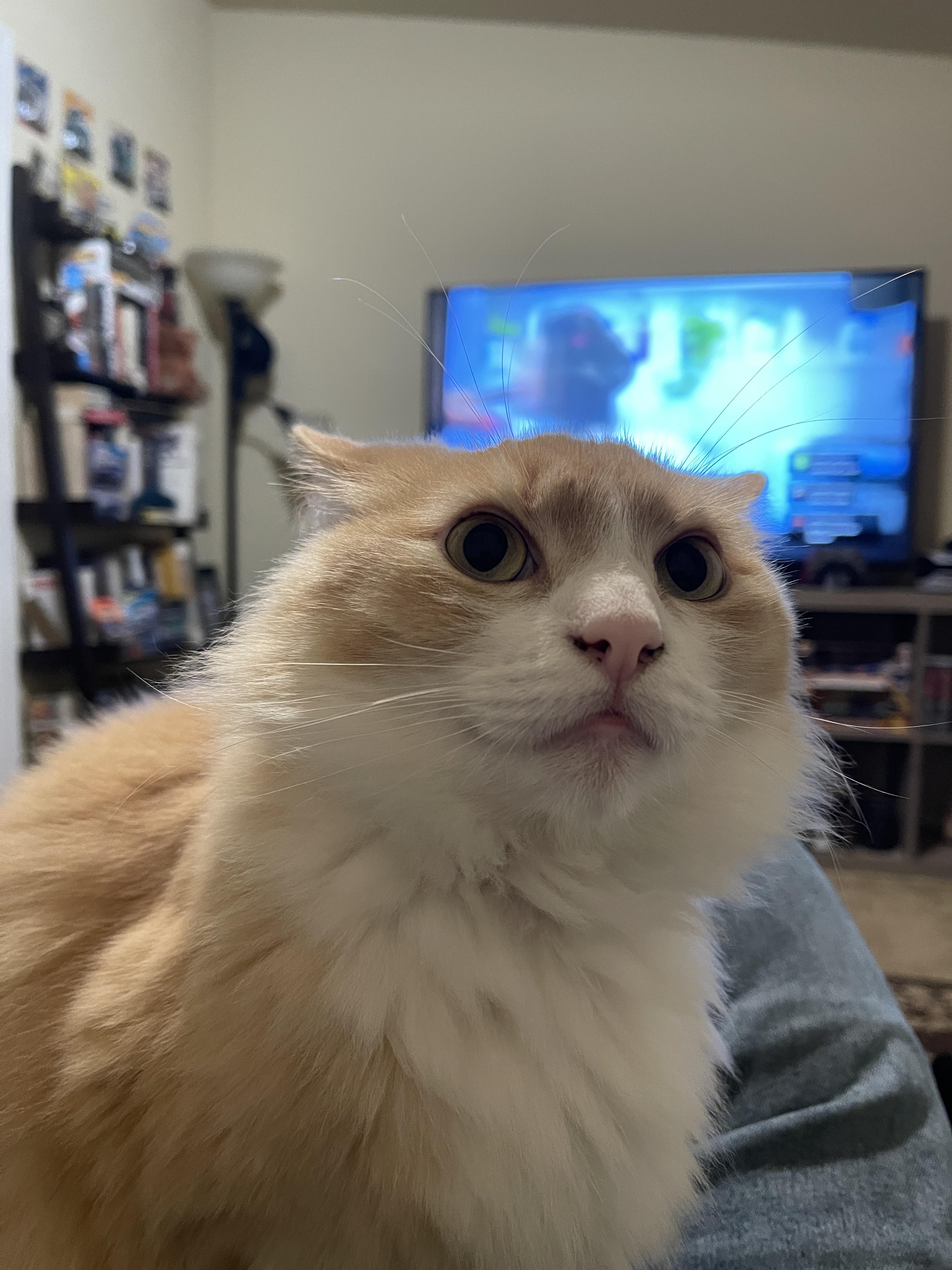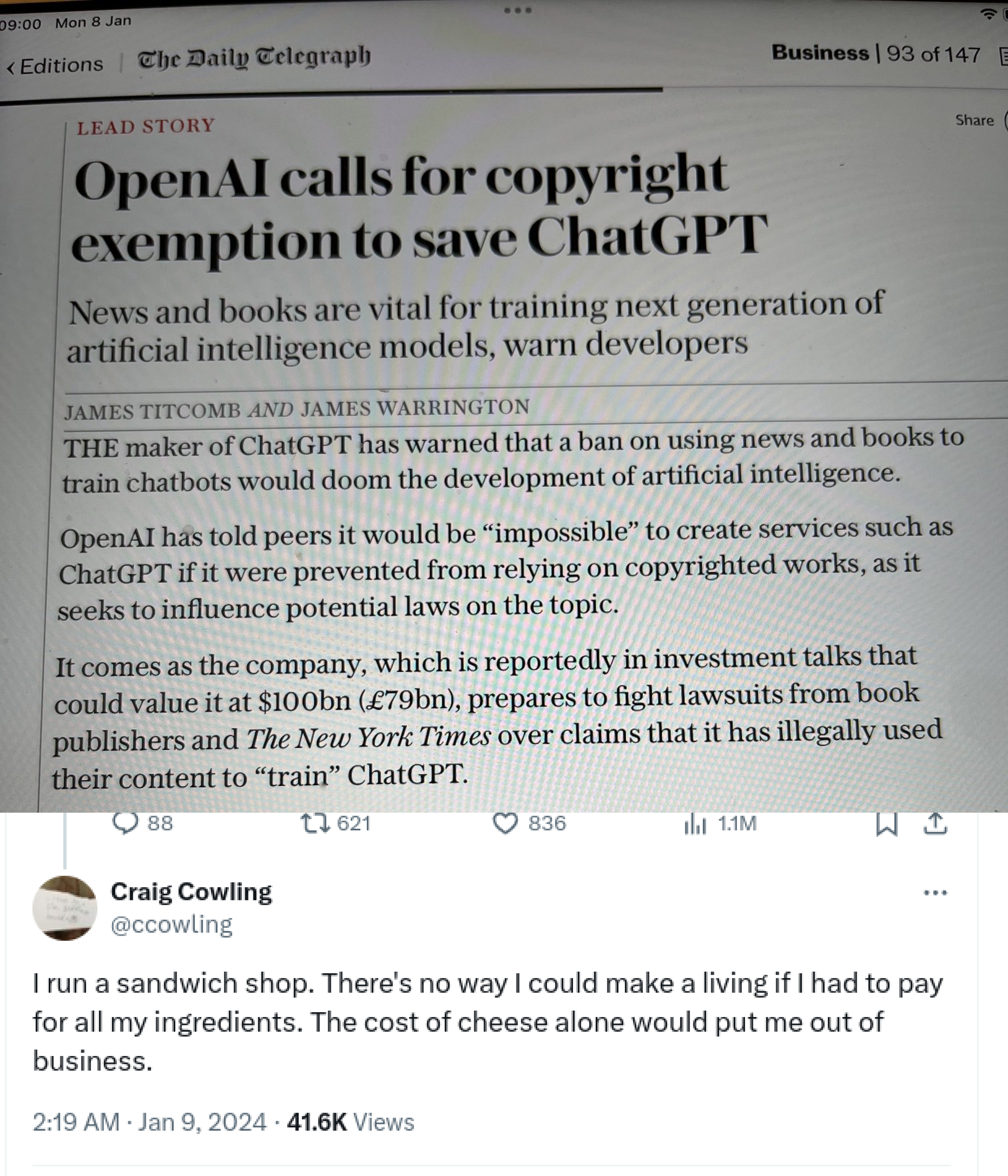Those claiming AI training on copyrighted works is “theft” misunderstand key aspects of copyright law and AI technology. Copyright protects specific expressions of ideas, not the ideas themselves. When AI systems ingest copyrighted works, they’re extracting general patterns and concepts - the “Bob Dylan-ness” or “Hemingway-ness” - not copying specific text or images.
This process is akin to how humans learn by reading widely and absorbing styles and techniques, rather than memorizing and reproducing exact passages. The AI discards the original text, keeping only abstract representations in “vector space”. When generating new content, the AI isn’t recreating copyrighted works, but producing new expressions inspired by the concepts it’s learned.
This is fundamentally different from copying a book or song. It’s more like the long-standing artistic tradition of being influenced by others’ work. The law has always recognized that ideas themselves can’t be owned - only particular expressions of them.
Moreover, there’s precedent for this kind of use being considered “transformative” and thus fair use. The Google Books project, which scanned millions of books to create a searchable index, was ruled legal despite protests from authors and publishers. AI training is arguably even more transformative.
While it’s understandable that creators feel uneasy about this new technology, labeling it “theft” is both legally and technically inaccurate. We may need new ways to support and compensate creators in the AI age, but that doesn’t make the current use of copyrighted works for AI training illegal or unethical.
For those interested, this argument is nicely laid out by Damien Riehl in FLOSS Weekly episode 744. https://twit.tv/shows/floss-weekly/episodes/744



The problem with your argument is that it is 100% possible to get ChatGPT to produce verbatim extracts of copyrighted works. This has been suppressed by OpenAI in a rather brute force kind of way, by prohibiting the prompts that have been found so far to do this (e.g. the infamous “poetry poetry poetry…” ad infinitum hack), but the possibility is still there, no matter how much they try to plaster over it. In fact there are some people, much smarter than me, who see technical similarities between compression technology and the process of training an LLM, calling it a “blurry JPEG of the Internet”… the point being, you wouldn’t allow distribution of a copyrighted book just because you compressed it in a ZIP file first.
Exactly! This is the core of the argument The New York Times made against OpenAI. And I think they are right.
The examples they provided were for very widely distributed stories (i.e. present in the data set many times over). The prompts they used were not provided. How many times they had to prompt was not provided. Their results are very difficult to reproduce, if not impossible, especially on newer models.
I mean, sure, it happens. But it’s not a generalizable problem. You’re not going to get it to regurgitate your Lemmy comment, even if they’ve trained on it. You can’t just go and ask it to write Harry Potter and the goblet of fire for you. It’s not the intended purpose of this technology. I expect it’ll largely be a solved problem in 5-10 years, if not sooner.
I agree. You can’t just dismiss the problem saying it’s “just data represented in vector space” and on the other hand not be able properly censor the models and require AI safety research. If you don’t know exactly what’s going on inside, you also can’t claim that copyright is not being violated.
It honestly blows my mind that people look at a neutral network that’s even capable of recreating short works it was trained on without having access to that text during generation… and choose to focus on IP law.
Right! Like if we could honestly further enhance that feature its an incredible increase in compression tech!
What method still works? I’d like to try it.
I have access to ChatGPT 4, and the latest Anthropic model.
Edit: hm… no answers but downvotes. I wonder why that is.
This would be a good point, if this is what the explicit purpose of the AI was. Which it isn’t. It can quote certain information verbatim despite not containing that data verbatim, through the process of learning, for the same reason we can.
I can ask you to quote famous lines from books all day as well. That doesn’t mean that you knowing those lines means you infringed on copyright. Now, if you were to put those to paper and sell them, you might get a cease and desist or a lawsuit. Therein lies the difference. Your goal would be explicitly to infringe on the specific expression of those words. Any human that would explicitly try to get an AI to produce infringing material… would be infringing. And unknowing infringement… well there are countless court cases where both sides think they did nothing wrong.
You don’t even need AI for that, if you followed the Infinite Monkey Theorem and just happened to stumble upon a work falling under copyright, you still could not sell it even if it was produced by a purely random process.
Another great example is the Mona Lisa. Most people know what it looks like and if they had sufficient talent could mimic it 1:1. However, there are numerous adaptations of the Mona Lisa that are not infringing (by today’s standards), because they transform the work to the point where it’s no longer the original expression, but a re-expression of the same idea. Anything less than that is pretty much completely safe infringement wise.
You’re right though that OpenAI tries to cover their ass by implementing safeguards. Which is to be expected because it’s a legal argument in court that once they became aware of situations they have to take steps to limit harm. They can indeed not prevent it completely, but it’s the effort that counts. Practically none of that kind of moderation is 100% effective. Otherwise we’d live in a pretty good world.
Y’all should really stop expecting people to buy into the analogy between human learning and machine learning i.e. “humans do it, so it’s okay if a computer does it too”. First of all there are vast differences between how humans learn and how machines “learn”, and second, it doesn’t matter anyway because there is lots of legal/moral precedent for not assigning the same rights to machines that are normally assigned to humans (for example, no intellectual property right has been granted to any synthetic media yet that I’m aware of).
That said, I agree that “the model contains a copy of the training data” is not a very good critique–a much stronger one would be to simply note all of the works with a Creative Commons “No Derivatives” license in the training data, since it is hard to argue that the model checkpoint isn’t derived from the training data.
Not really. First of all, creative commons strictly loosens the copyright restrictions on a work. The strongest license is actually no explicit license i.e. “All Rights Reserved.” No derivatives is already included under full, default, copyright.
Second, derivative has a pretty strict legal definition. It’s not enough to say that the derived work was created using a protected work, or even that the derived work couldn’t exist without the protected work. Some examples: create a word cloud of your favorite book, analyze the tone of news article to help you trade stocks, produce an image containing the most prominent color in every frame of a movie, or create a search index of the words found on all websites on the internet. All of that is absolutely allowed under even the strictest of copyright protections.
Statistical analysis of copyrighted materials, as in training AI, easily clears that same bar.
Equating LLMs with compression doesn’t make sense. Model sizes are larger than their training sets. if it requires “hacking” to extract text of sufficient length to break copyright, and the platform is doing everything they can to prevent it, that just makes them like every platform. I can download © material from YouTube (or wherever) all day long.
Excuse me, what? You think Huggingface is hosting 100’s of checkpoints each of which are multiples of their training data, which is on the order of terabytes or petabytes in disk space? I don’t know if I agree with the compression argument, myself, but for other reasons–your retort is objectively false.
Just taking GPT 3 as an example, its training set was 45 terabytes, yes. But that set was filtered and processed down to about 570 GB. GPT 3 was only actually trained on that 570 GB. The model itself is about 700 GB. Much of the generalized intelligence of an LLM comes from abstraction to other contexts.
*Did some more looking, and that model size estimate assumes 32 bit float. It’s actually 16 bit, so the model size is 350GB… technically some compression after all!
They’re absolutely not doing everything they can. Everything they can would be to not use the works. They’re doing as much as they’re willing to do. If it wasn’t for the threat of lawsuits they wouldn’t even be doing that much.
How do you imagine those works are used?
The issue isn’t that you can coax AI into giving away unaltered copyrighted books out of their trunk, the issue is that if you were to open the hood, you’d see that the entire engine is made of unaltered copyrighted books.
All those “anti hacking” measures are just there to obfuscate the fact that that the unaltered works are being in use and recallable at all times.
This is an inaccurate understanding of what’s going on. Under the hood is a neutral network with weights and biases, not a database of copyrighted work. That neutral network was trained on a HEAVILY filtered training set (as mentioned above, 45 terabytes was reduced to 570 GB for GPT3). Getting it to bug out and generate full sections of training data from its neutral network is a fun parlor trick, but you’re not going to use it to pirate a book. People do that the old fashioned way by just adding type:pdf to their common web search.
Again: nobody is complaining that you can make AI spit out their training data because AI is the only source of that training data. That is not the issue and nobody cares about AI as a delivery source of pirated material. The issue is that next to the transformed output, the not-transformed input is being in use in a commercial product.
Are you only talking about the word repetition glitch?